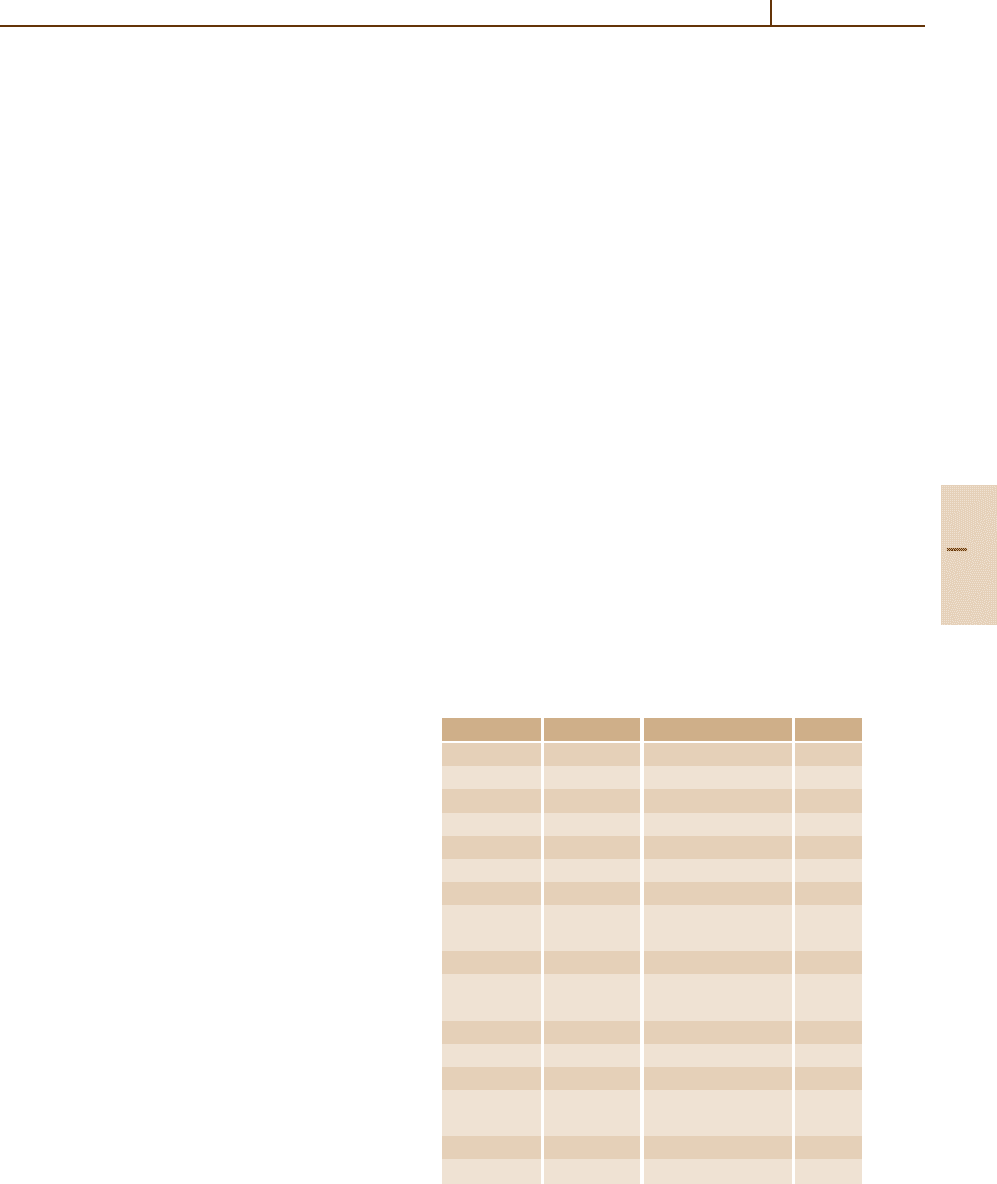Drake G.W.F. (editor) Handbook of Atomic, Molecular, and Optical Physics
Подождите немного. Документ загружается.


Spectroscopic Techniques: Cavity-Enhanced Methods 43.4 Extensions to Solids and Liquids 639
the photodetector, and the FM modulation index. NICE-
OHMS has exploited cavities having a finesse of 100 000
to achieve sensitivities of 1 × 10
−14
cm
−1
Hz
−1/2
. NICE-
OHMS holds the world record in detection sensitivity of
all cavity enhanced techniques.
In a NICE-OHMS experiment, phase modulation of
the laser produces side bands that are set to equal the
free spectral range of the high finesse resonator. Be-
cause the sidebands are transmitted by the cavity in the
same manner as the carrier, any small wavelength fluc-
tuations in the laser or small optical phase shifts of the
transmitted carrier that contribute to noise in the trans-
mitted intensity will appear identically in the sidebands.
After demodulation, this noise will cancel out. Thus, the
transmitted carrier and sidebands are an accurate repre-
sentation of the carrier and sidebands impinging on the
input mirror of the cavity. The carrier laser frequency is
locked to the peak of the optical cavity mode and tracks
this mode if the cavity length is changed in order to pro-
duce a spectral scan. The sidebands are detected and
demodulated as in conventional FM spectroscopy. The
key to NICE-OHMS is that the noise level can approach
the intrinsic shot noise of the laser at the FSR frequency
(namely hundreds of MHz).
If there is no sample in the cavity, the transmitted
sidebands will cancel after demodulation because they
have opposite phases. No signal will be observed. If there
is a sample in the cavity, the sidebands will experience
different transmission amplitudes, so that demodulation
will produce a signal proportional to the difference in
absorption between the sideband frequencies. In addi-
tion, the absorption feature produces a phase shift that
pulls the carrier cavity mode frequency, so that the side-
bands become detuned from the mode peak and acquire
a phase shift on transmission. This sideband phase shift
contributes to the demodulated signal.
43.4 Extensions to Solids and Liquids
Thus far, the discussion of cavity-enhanced techniques
has addressed traditional optical resonators formed us-
ing high reflectivity dielectric mirrors that encompass
gas samples. Extensions of cavity enhanced methods to
liquid and solid media has required additional innova-
tion, specifically in the optical cavities used.
Evanescent-wave CRDS (EW-CRDS) exploits the
fact that total internal reflection allows probing the sur-
face layer of a sample in contact with a prism. The
simplest configuration places a Brewster prism inside
a linear ring-down cavity. The prism folds the cavity
beam path by 90 degrees, thereby producing one point
in the prism having total internal reflection [43.22]. The
evanescent wave produced by this internal reflection can
be used to probe liquid or solid samples. Another pos-
sible embodiment is a ring cavity having its optical path
inside a multi-faceted polygon, where at each facet, total
internal reflection occurs [43.23]. Light is coupled into
and out from the polygon by photon tunneling – which
effectively controls the overall finesse of the cavity. The
absorbing sample material can then be placed on any
one or more of the polygon facets, and its detection is
done using the polygon’s evanescent waves.
Fiber cavities are attractive because they can extend
the use of CRDS into harsh environments, can probe
liquids as well as gases, and can be used to measure
pressure [43.24]. The high reflectivity mirrors on each
end of the fiber can be either dielectrically coated, as
in a traditional ring-down cavity design, or can con-
sist of Fiber Bragg gratings. Fiber-based CRDS has also
been applied to detection in liquid media via a fiber
loop cavity wherein a liquid sample replaced the index
matching fluid in the gap between fibers at the connec-
tor splice [43.25]. This approach produced a 100-fold
enhancement over linear detection.
More direct approaches to measuring liquid samples
involved confining the liquid samples within a more tra-
ditional RDC. The most direct method involves placing
a liquid directly into the cavity, but this approach re-
sults in very limited sensitivity. By placing a Brewster
cell filled with liquid sample in a RDC, the sensitivity
of the P-CRDS can be slightly improved. By matching
the Brewster angles to the refractive indices of the adja-
cent media (the outside angle matches the air-filled RDC,
while the inner angle matches the index of the liquid), the
sensitivity can be dramatically improved [43.26]. The
peak-to-peak baseline noise level of such a P-CRDS sys-
tem was 1.0×10
−5
absorbance units (AU), rivaling the
best available commercial ultraviolet-visible (UV-VIS)
direct absorption detectors. The performance remained
limited by the excitation of multiple cavity modes
A CW-CRDS system using the same angle-matched
Brewster cell [43.27] improved the peak-to-peak base-
line noise by a factor of 50 to 2 × 10
−7
AU.ThisCRDS
detector outperformed the best commercially available
UV-VIS detector by a factor of 30, again illustrating
the potential for CRDS to replace standard absorption
spectroscopy techniques.
Part C 43.4

640 Part C Molecules
Solid samples have also been placed inside linear
CRDS cavities for characterization. Mostly, P-CRDS
are used. Examples of applications include character-
ization of C-60 films, thin-film coatings, and silicon
wafers.
It is anticipated that CRDS will eventually reach
sensitivities for liquid and thin film samples that
are comparable to those achieved in gases. CRDS
is also expected to find commercial applications in
high performance liquid chromatography, thin film
characterization, and biological detection. Combination
techniques of CRDS and fluorescence, or CRDS and
Raman spectroscopy, may also be on the not-so-distant
horizon, where CRDS provides the quantification,
while the complementary technique provides identifi-
cation [43.28].
References
43.1 K. W. Busch (Ed.): Cavity Ringdown Spectroscopy:
An Ultratrace Absorption Measurement Technique,
ACS Symp. Ser., Vol. 720 (Oxford Univ. Press, Wash-
ington 1997)
43.2 A. O’Keefe, D. A. G. Deacon: Rev. Sci. Instrum. 59,
2544 (1988)
43.3 R. Engeln, G. Meijer: Rev. Sci. Instrum. 67, 2708
(1996)
43.4 R. Engeln, G. Bierden, E. van den Berg, G. Meijer:
J. Chem. Phys. 107, 4458 (1997)
43.5 E. R. Crosson, P. Haar, G. A. Marcus, H. A. Schwett-
man, B. A. Paldus, T. G. Spence, R. N. Zare: Rev. Sci.
Instrum. 70, 4 (1999)
43.6 R. D. van Zee, J. T. Hodges, J. P. Looney: Appl. Opt.
38, 3951 (1999)
43.7 D. Romanini, A. A. Kachanov, N. Sadeghi,
F. Stoeckel: Chem. Phys. Lett. 270, 538 (1997)
43.8 B. A. Paldus, R. N. Zare: U.S. Patent #6 466 322
43.9 T. G. Spence, C. C. Harb, B. A. Paldus, R. N. Zare,
B. Willke, R. L. Byer: Rev. Sci. Instrum. 71, 347 (2000)
43.10 K. K. Lehmann, P. Rabinowitz: U.S. Patent
#5 973 864
43.11 F. Kuhnemann, F. Muller, B. von Basun, D. Halmer,
A. Popp, S. Schiller, P. Hering, M. Murtz: SPIE Proc
5337, paper 18 (SPIE, Bellingham 2004)
43.12 R. Engeln, G. Von Helden, G. Berden, G. Meijer:
Chem. Phys. Lett. 262, 105 (1996)
43.13 M. D. Levenson, B. A. Paldus, T. G. Spence,
C. C. Harb, J. S. Harris, R. N. Zare: Chem. Phys. Lett.
290, 335 (1998)
43.14 D. Romanini, A. A. Kachanov, J. Morville, M. Chene-
vier: EOS/SPIE International Symp. on Ind. Lasers
Inspection Envirosense, 3821, 94 (SPIE, Bellingham
1999)
43.15 H. Naus, I. H. M. van Stokkum, W. Hogervorst,
W. Ubachs: Appl. Opt. 40, 4416 (2001)
43.16 D. Halmer, G. von Basum, P. Hering, M. Murtz: Rev.
Sci. Instrum. 75, 2187 (2004)
43.17 R. Engeln, G. Berden, E. vandenBerg, G. Meijer: J.
Chem. Phys. 107, 4458 (1997)
43.18 A. O’Keefe, J. J. Scherer, J. B. Paul: Chem. Phys. Lett.
307, 343 (1999)
43.19 J. B. Paul, L. Lapson, J. G. Anderson: Appl. Opt. 40,
4904 (2001)
43.20 L. Gianfrani, R. W. Fox, L. Hollberg: J. Opt. Soc. Am.
B 16, 2247 (1999)
43.21 J. Ye, L. S. Ma, J. L. Hall: J. Opt. Soc. Am. B 15,6
(1998)
43.22 A. C. R. Pipino, J. W. Hudgens, R. E. Huie: Rev. Sci.
Instrum. 68, 2978 (1997)
43.23 A. C. R. Pipino: Phys. Rev. Lett. 83, 3093 (1999)
43.24 T. von Lerber, M. W. Sigrist: Appl. Opt. 41, 3567
(2002) and EP00121314.9
43.25 R. S. Brown, I. Kozin, Z. Tong, R. D. Oleschuk,
H. P. Loock: J. Chem. Phys. 117, 10444 (2002)
43.26 K. Snyder, R. N. Zare: Anal. Chem. 75, 3086 (2003)
43.27 K. Snyder, R. N. Zare, A. A. Kachanov, B. A. Paldus:
Anal. Chem. 77, 1177 (2005)
43.28 B. A. Richmann, A. A. Kachanov, B. A. Paldus,
A. W. Strawa: Opt. Express 13, 3376 (2005)
Part C 43

641
Spectroscopic
44. Spectroscopic Techniques: Ultraviolet
The design of UV spectroscopic experiments
and apparatus must conform to the constraints
associated with producing, dispersing, and
detecting UV photons. In this chapter, we
review the instrumentation available for UV
spectroscopy, concentrating on the VUV,where
special instrumentation is necessary. Recent
advances are stressed, particularly in the areas of
synchrotron radiation and the production of VUV
laser light.
The most inclusive, up-to-date review
of vacuum ultraviolet techniques is Vacuum
Ultraviolet Spectroscopy I & II (1998), edited by
Samson and Ederer [44.1]. This text significantly
expands on Samson’s classic, authoritative
review of VUV instrumentation, first published
in 1967 [44.2]. There are many comprehensive
reviews of VUV light sources, spectrometers, and
44.1 Light Sources....................................... 642
44.1.1 Synchrotron Radiation ............... 642
44.1.2 Laser-Produced Plasmas ............ 643
44.1.3 Arcs, Sparks, and Discharges ....... 644
44.1.4 Supercontinuum Radiation......... 644
44.2 VUV Lasers........................................... 645
44.3 Spectrometers ..................................... 647
44.3.1 Grating Spectrometers ............... 647
44.3.2 Fourier Transform
Spectrometers........................... 648
44.4 Detectors ............................................ 648
44.5 Optical Materials ................................. 651
References .................................................. 652
detectors, which are referenced in the appropriate
sections of this chapter.
The ultraviolet (UV) spectral region extends from the
short wavelength side of the visible, about 400 nm, to
the long wavelength side of the X-ray region at ap-
proximately 10 nm. Ultraviolet photon energies range
from about 3 to 120 eV. Because laboratory air at
STP does not transmit below about 200 nm, the UV
region is conventionally subdivided into the near ul-
traviolet, wavelengths λ>200 nm, and the vacuum
ultraviolet (VUV), λ<200 nm. Further subdivisions
are widespread, but not uniformly adopted. The term
middle ultraviolet (MUV) is sometimes used to des-
ignate the 200 to 300 nm wavelength region, with
the term near UV used only for 300 to 400 nm.
VUV wavelengths are often divided into the far ul-
traviolet (FUV), 100 to 200 nm, and the extreme
ultraviolet (EUV), 10 to 100 nm. In this review, we
will simply refer to the UV (10 to 400 nm), the
near UV (200 to 400 nm), and the VUV (10 to
200 nm).
The absorption of UV radiation by atoms and
molecules involves transitions to highly excited dis-
crete and continuum levels. The relevant atomic and
molecular physics of highly excited states is discussed
in Chapts. 14, 24, 25,and61. Ultraviolet absorption
initiates many important photochemical reactions; ap-
plications in astrophysics, aeronomy, and combustion
are reviewed in Chapts. 82, 84,and88.Theex-
perimental techniques used at ultraviolet wavelengths
include high-resolution spectroscopic measurements of
wavelengths and line shapes (Chapt. 10) , absolute pho-
toabsorption oscillator strength and radiative lifetime
measurements (Chapt. 17), fluorescence spectroscopy,
and energy, angle, and spin-resolved photoelectron spec-
troscopy (Chapt. 61).
Part C 44

642 Part C Molecules
44.1 Light Sources
44.1.1 Synchrotron Radiation
Synchrotron radiation (SR) facilities provide intense
continuum radiation in the visible, UV, and soft X-ray
spectral regions. The radiation is emitted by relativis-
tic electrons (or positrons) accelerated by the Lorentz
force of a magnetic field. In addition to its contin-
uum nature, synchrotron radiation is characterized by
high degrees of collimation and polarization. Advances
in specialized magnet designs, e.g., wigglers and un-
dulators, that dramatically increase spectral brightness
at selectable wavelengths, have stimulated continuing
growth in synchrotron-radiation-based spectroscopic re-
search. References [44.3–13] gi ve general reviews on the
nature of synchrotron radiation and on specific SR-based
experimental techniques.
SR facilities use either a linear accelerator,
a microtron, or a synchrotron to accelerate electrons or
positrons to relativistic energies (0.1to10GeV).The
particles are then injected into a storage ring, where a se-
ries of bending magnets steers them in a closed orbit.
The particles in the storage ring radiate energy, which
is replaced by radio frequency accelerating cavities that
are part of the ring. These accelerating systems pro-
duce well-defined, regularly spaced bunches of stored
particles, so that radiation from SR facilities is character-
ized by sub-nanosecond pulses at 1 to 10 MHz repetition
rates.
Typical storage ring currents are on the order of
100 to 1 A. The current decreases continuously be-
cause of collisions with residual gas molecules
and electron–electron (or positron–positron) scattering.
Beam lifetimes in most facilities range from a few to
about 20 hours. The longest lifetimes are achieved by
positron beams, which repel any ions produced in resid-
ual gas collisions. Storage ring pressures must be in the
10
−10
Torr range in order to reduce collisions to accept-
able levels; such pressure requirements can restrict the
types of measurements performed at SR facilities.
The spectral properties of synchrotron radiation can
be derived from Larmor’s formula for an accelerat-
ing relativistic charged particle [44.4, 14–18]. The total
power P radiated by a beam of current I and energy E
in a bending magnet field B is
P = 0.0265E
3
IBkW , (44.1)
where, throughout this chapter, I is in mA, E is in GeV,
and B is in Tesla. For example, a 300 mA beam of 1 GeV
electrons radiates about 8 kW when traversing the field
of a typical 1.0 T bending magnet. One-half of the to-
tal power is radiated above the critical wavelength, λ
c
,
where
λ
c
= 1.9/
BE
2
nm .
(44.2)
For the example just considered, λ
c
= 1.9nm.
The power radiated by, and the flux from, syn-
chrotron radiation sources is often expressed per
fractional (or percent) bandwidth. For example the
flux Φ, in units of photons
cm
2
s
−1
, at 10 nm (124 eV)
per 1% bandwidth is the flux in a 0.1nmbandat10nm,
which is the same as that in a 1.24 eV energy band.
The radiated power per fractional bandwidth peaks at
λ ≈ 0.75 λ
c
.
The flux per fractional bandwidth reaches a broad
maximum at λ ≈ 3.3 λ
c
and decreases slowly at longer
wavelengths, with a limiting behavior that is propor-
tional to λ
−1/3
for λ λ
c
. Thus, although the photon
flux typically peaks in the soft X-ray region, a high flux is
also present throughout the VUV wavelength range. Be-
low λ
c
, the flux drops rapidly, with little usable radiation
at wavelengths below about 0.1 λ
c
.
The angular distribution of the radiated light is
sharply peaked in the instantaneous direction of the
beam of radiating particles. Practically all the radiation
is emitted into an opening half-angle θ that at λ = λ
c
is
equal to 1/γ ,whereγ = E/mc
2
;i.e.,
θ = 1/γ = 5.11 × 10
−4
/E rad . (44.3)
Radiation from beams with energies of a few GeV has
a divergence somewhat less than 1 mrad at λ
c
.The
divergence increases at longer wavelengths, with
θ ≈ (γ)
−1
(λ/λ
c
)
1/3
rad . (44.4)
Radiation from bending magnets maintains this narrow
divergence only in the vertical plane; in the orbital plane,
the radiation is emitted in an opening angle equal to
the bending angle of the magnet. Typical beam cross
sections are 0.01 to 1 mm
2
. Thus, the extremely high
spectral brightness, i. e., photon flux per unit solid angle
and % bandwidth, of synchrotron sources reflects both
the very low divergence of the radiation and the small
source size. A typical brightness associated with bend-
ing magnet radiation is on the order of 10
12
photons
(s mm
2
mrad
2
0.1% bandwidth)
−1
.
Synchrotron radiation has well-characterized polar-
ization properties. Within the orbital plane the radiation
is completely linearly polarized with the electric field
Part C 44.1

Spectroscopic Techniques: Ultraviolet 44.1 Light Sources 643
vector in the orbital plane; above and below the orbital
plane the radiation is elliptically polarized, with the de-
gree of polarization dependent on both wavelength and
viewing angle. Undulator designs incorporating either
crossed planar magnets or a helical array of magnets
can produce circularly polarized light (e.g., [44.19]),
allowing for the development of circular dichroism spec-
troscopies in the vacuum ultrav iolet [44.20].
The pulsed nature of the radiation at synchrotron
facilities is ideal for sub-nanosecond time-resolved spec-
troscopies [44.21–25]. Electron bunch lengths l
b
are
typically a few centimeters; radiation is observed from
each bunch for a time interval approximately equal to
l
b
/c ≈ 100 ps. The time for one full orbit is determined
by the size of the storage ring and varies from about
20 ns at the smallest rings to 500 to 1000 ns at the larger
rings. The number of bunches is typically on the order
of a few hundred, resulting in pulse repetition rates from
a few MHz to about 500 MHz.
Many synchrotron facilities incorporate straight
sections between bending magnets to accommodate in-
sertion devices such as wigglers and undulators. These
are linear arrays of magnets with alternating polarities
that cause the beam trajectory to oscillate, although no
net displacement of the beam occurs. The oscillations
produce synchrotron radiation that is characterized by
extremely high brightness and that can be spectrally
tailored to individual experiments [44.4, 13, 17, 26, 27].
Wigglers and undulators are distinguished by the
value of their deflection parameter K, which is a measure
of the maximum bending angle of the stored particle
beam in units of θ, the angular divergence of the emitted
radiation. The deflection parameter K is determined by
the peak strength of the alternating magnetic field B
0
and its spatial period x
B
by
K = 0.934B
0
x
B
, (44.5)
with x
B
in cm.
In the wiggler regime, K 1; i. e., the angle at
which the magnets deflect the electron beam is large
compared with θ. The resulting spectrum resembles that
from a bending magnet, but is brighter by a factor of
N
m
, the number of magnet periods (usually 10 to 100).
Wigglers are generally used as wavelength shifters; mag-
netic fields larger than those available in conventional
bending magnets decrease the critical wavelength of the
spectral distribution and shift the overall spectrum to
shorter wavelengths.
In the undulator regime, K 1; i. e., the angle at
which the electrons are deflected is close to θ and ra-
diation from individual oscillations adds coherently at
certain resonant wavelengths, producing a gain of N
2
m
.
Undulator radiation is characterized by sharp peaks at
a fundamental wavelength λ
1
and its odd harmonics.
λ
1
is determined by the beam energy and x
B
:
λ
1
≈ 0.1 x
B
/
2γ
2
= 1.3 x
B
E
−2
nm , (44.6)
where x
B
is in cm. For example, the fundamental
wavelength is 6.5 nm for a 1 GeV beam traversing an
undulator with a spatial period of 5 cm. The fractional
bandwidth of the peaks in an undulator spectrum is
≈ 1/N
m
. Unlike the radiation from a bending mag-
net, the angular divergence of undulator radiation is
sharply peaked both vertically and in the orbital plane;
the brightness of undulator radiation is ≈ 10
18
to
10
19
photons/(s mm
2
mrad
2
0.1% bandwidth), about six
orders of magnitude greater than bending magnet radia-
tion. The wavelength of the fundamental is tunable; the
strength of the peak magnetic field is altered via changes
in the size of the gaps between the poles of the magnets.
44.1.2 Laser-Produced Plasmas
When the output of a high-power pulsed laser is fo-
cused onto a solid target, a short-lived, high-temperature
(T ≈ 50 to 100 eV), high-density
n
e
≈ 10
21
cm
−3
plasma is created. The radiation from certain target
materials, particularly the rare earths (57 ≤ Z ≤ 71)
and neighboring metals on the periodic table, produces
a strong VUV quasicontinuum that is essentially free
of discrete lines [44.28, 29]. The continua are most in-
tense in the 4 to 30 nm region but often extend to about
180 nm. A review of laser-produced plasmas and their
applications in the VUV can be found in [44.30].
The primary mechanisms responsible for the con-
tinua are recombination radiation (ionization stages up
to ≈ 16 are attained) and bremsstrahlung. The ab-
sence of discrete features in rare earth plasmas is
thought to be caused by the extreme complexity of
rare earth atomic energy level structures; individual
emission lines are blended into an apparent contin-
uum [44.31]. The necessary peak laser powers, which
are in the range of 10
10
to 10
11
Wcm
−2
[44.32, 33],
are easily achieved with most commercially available
Q-switched lasers. The continuum pulse duration is
comparable to the duration of the laser pulse. Peak out-
put intensities are significantly greater than those from
other pulsed table-top continuum sources such as spark
discharges; synchrotron sources produce much higher
average intensities [44.33]. The target material is usu-
ally a cylindrical rod that is rotated to present a fresh
surface for each laser shot. References [44.32, 34–38]
Part C 44.1

644 Part C Molecules
present and discuss the spectral characteristics of several
laser-produced plasma sources. Atomic photoabsorption
techniques based on laser-produced plasma sources are
described in [44.33, 39–41].
44.1.3 Arcs, Sparks, and Discharges
Several laboratory sources of VUV line and continuum
radiation are based on gas discharges, high-pressure
arcs, and low-pressure and vacuum sparks. While these
well-established radiation sources are not as intense as
synchrotron radiation and laser-produced plasmas, the
traditional sources have the advantages of being portable
and inexpensive. Reviews can be found in [44.42, 43]
H
2
and D
2
Discharges
Direct current discharges (approximately 100 to
500 mA) through 1 to 2 Torr of H
2
or D
2
generate con-
tinuum radiation from about 165 to 350 nm [44.2, 44].
The continuum is produced by transitions from the
bound 1sσ 2sσ a
3
Σ
+
g
state to the repulsive 1sσ 2pσ b
3
Σ
+
u
state [44.45]; the very steep potential curve of the lower
state results in the extended nature of the continuum. The
photon flux per unit wavelength from such lamps peaks
at about 185 nm; below 165 nm the many-line spectra of
H
2
or D
2
begin to dominate.
Ar Mini-Arc
A high-current (20 to 50 A) wall-stabilized arc dis-
charge through 1 to 2 atm of Ar, known as a mini-arc,
produces a continuum associated with recombination
radiation. The continuum extends from the near UV
down to approximately 110 nm [44.44, 46]. The stabil-
ity and reproducibility of the output of the mini-arc has
led to its use as a secondary radiometric standard in the
VUV [44.46, 47].
Noble Gas Discharges
High voltage (10 kV), mildly condensed, repetitive
(5 kHz) discharges through the noble gases produce
continua associated with molecular transitions between
bound excited states and the very weakly bound ground
states of the noble gas dimers [44.2, 48, 49]. These con-
tinua begin at the first resonance line of the atomic
species and extend a few tens of nanometers to longer
wavelengths. For example, the onset of the He contin-
uum is approximately 59 nm, while the useful continuum
extends from 65 to 95 nm with a peak intensity at about
80 nm. Discharges through He, Ar, Kr, and Xe cover
the 65 to 180 nm region. Optimum discharge pressures
vary from about 40 Torr for He up to a few hundred Torr
for Kr and Xe. Differential pumping is required when
using these discharge sources at wavelengths shortward
of 105 nm, the short wavelength transmission limit of
window materials (see Sect. 44.5).
Flash Discharges and Vacuum Sparks
Flash discharges of approximately 1 µs duration through
low-pressure (approximately 0.02 Torr) gases in ceramic
or glass capillaries yield useful continua down to about
30 nm [44.2,50]. The continua are produced by passage
of the discharge through sputtered wall materials and are
independent of the carrier gas. The BRV source [44.51],
a pulsed vacuum spark with extremely low inductance,
utilizes a high-Z anode (e.g., W or U) to generate
a smooth continuum down to about 10 nm. The short
pulse duration (approximately 50 ns) [44.52] and well-
defined triggering make this source useful for transient
absorption studies at short wavelengths.
Line Radiation Sources
Hollow cathode discharges [44.53, 54], which are
easy and inexpensive to construct and operate, are
the most common line-emission sources used in UV
spectroscopy. Low power (approximately 5 W) lamps
designed to produce the spectra of about 70 elements are
commercially available for spectrochemical and atomic
absorption spectroscopy. Line widths are narrow, so
blends are avoided. Most manufacturers can provide
lamps with special windows for use at VUV wavelengths
(Sect. 44.5).
High-current, differentially-pumped hollow cathode
sources, which have been developed for use as ra-
diometric standards in the 40 to 125 nm wavelength
range [44.55], can also be used as line sources. At shorter
wavelengths, e.g., 5 to 40 nm, the Penning discharge has
proved to be a useful source of line radiation [44.43, 56,
57]. Electron-beam excitation sources [44.43] produce
stable and reproducible line emission spectra and find
use as VUV calibration standards [44.54, 58]. Electron-
beam ion trap (EBIT) sources [44.59,60] generate VUV
and X-ray spectra of highly ionized atomic species.
44.1.4 Supercontinuum Radiation
Continua extending throughout the near UV wave-
length range to below 200 nm can be produced by
focusing femtosecond laser pulses in both liquids and
noble gases. This supercontinuum generation [44.61]
allows for time-resolved, sub-picosecond spectroscopy
of photochemical reactions [44.62, 63]. The supercon-
tinuum arises from a number of competing nonlinear
Part C 44.1

Spectroscopic Techniques: Ultraviolet 44.2 VUV Lasers 645
processes [44.64–66]. Access to the UV has been
demonstrated both by focusing 308 nm laser pulses
in water [44.67] and by focusing 248 nm laser pulses
in high pressure (10 to 40 atm) cells of Ne, Ar,
and Kr [44.68]. The continuum produced using H
2
O
is particularly broad, extending from 200 to 600 nm.
The neon continuum extends into the VUV to at
least 187 nm.
44.2 VUV Lasers
Advances in laser technologies hav e led to an impres-
sive increase in spectroscopically useful VUV laser
sources. Recent reviews can be found in [44.69, 70].
The following summary of VUV lasers does not cover
the rapidly developing fields of X-ray and soft X-ray
lasers [44.71, 72] or the development of free electron
lasers operating in the VUV ([44.73, 74] and references
therein).
Primary Lasers
Pulsed lasing at VUV wavelengths has been achieved in
a number of media, including the molecular gases H
2
,
CO, and F
2
, excimer systems (Ar
2
,Kr
2
,Xe
2
, ArF), and
Auger-pumped noble gases (Xe, Kr) [44.75]. The fun-
damental barrier to producing stimulated emission in the
VUV is the ν
3
dependence of the spontaneous emission
rate, which necessitates very high pump powers to cre-
ate and maintain population inversions. Existing VUV
primary lasers have generally not been widely used in
spectroscopic applications because of either a lack of
tunability or unacceptably broad line widths.
Pulsed lasing in CO, H
2
,andF
2
occurs between
rovibronic levels of a high-lying electronic state and ex-
cited vibrational levels of the ground electronic state.
The lasing output consists of discrete lines and is not
tunable. The CO and H
2
outputs [44.76, 77] span rela-
tively broad regions (181 to 197 nm and 110 to 164 nm,
respectively), while the F
2
laser output consists of two or
three closely-spaced lines at 157 nm [44.78]. Pulse en-
ergies are in the 1 to 100 µJ range for CO and H
2
lasers.
Commercially available F
2
lasers offer pulse energies of
about 50 mJ at 50 Hz repetition rates.
Noble-gas and noble-gas-halide excimer lasers op-
erate via bound-upper-level to continuum-lower-level
transitions. (Retrospective reviews of excimer laser tech-
nologies can be found in [44.79,80].) The resulting gain
profiles are broad and the outputs are typically tunable
over about 2 nm. ArF excimer systems (193 nm) are
pumped by high pressure gas discharges; lasers with
pulse energies of ≈ 20 to 40 mJ are commercially avail-
able. Xe
2
(173 nm), Kr
2
(146 nm), and Ar
2
(126 nm)
lasers [44.81–83] produce comparable pulse energies but
require electron beam excitation. Auger-pumped lasers
achieve a population inversion through the ejection of
an inner-shell electron from a neutral atom to produce
a highly excited singly ionized species, followed by
Auger decay to excited states of the doubly ionized
species. The soft X-ray (approximately 100 eV) pump
photons often originate from a laser-produced plasma.
The lasing output is nontunable. Lasing in Xe (108.9nm)
and Kr (90.7 nm) [44.84,85] has been achieved with out-
put pulses in the range of a few µJ, and Auger-pumped
lasing in Zn (at approximately 130 nm) has also been
reported [44.86].
Nonlinear Techniques
In the past thirty years, developments in the techniques
of nonlinear optics have extended the range of tun-
able, pulsed coherent radiation to VUV wavelengths.
Nonlinear frequency conversion techniques, such as
stimulated anti-Stokes Raman scattering, harmonic gen-
eration, and sum- and difference-frequency mixing (see
Chapt. 72) , can produce narrow-bandwidth radiation
spanning the entire VUV. The generated VUV radia-
tion has the spectral and spatial characteristics of the
input laser radiation. Pulses of 10
10
to 10
12
photons
are commonly generated with bandwidths on the order
of 0.1cm
−1
(2 × 10
−4
nm). Many review s are available
on this subject [44.75, 87–95]. The standard nonlinear
techniques for producing tunable coherent radiation with
λ<200 nm are summarized below.
Second harmonic generation in nonlinear optical
crystals is a well-established method for generating
tunable laser light in the near UV (Chapt. 42). At the
shortest wavelengths, second harmonic generation in β-
barium borate (BBO) produces usable outputs down to
approximately 205 nm, below which the phase matching
requirement between the fundamental and the sec-
ond harmonic cannot be met. Sum-frequency mixing
(ω = ω
1
+ ω
2
) in BBO [44.96,97], where ω
1
is typically
the Nd:YAG fundamental (1064 nm) and ω
2
is tunable
UV light, extends the useful range of BBO to approxi-
mately 190 nm, where the crystal begins to exhibit strong
absorption.
Stimulated anti-Stokes Raman scattering of UV laser
light in molecular gases (e.g., H
2
,N
2
,CH
4
)isused
Part C 44.2

646 Part C Molecules
to generate coherent radiation down to about 120 nm,
although low conversion efficiencies often restrict the us-
able output to λ>160 nm. The scattering is a four-wave
mixing process resulting in a series of output frequen-
cies shifted from the pump laser frequency by multiples
of the vibrational splitting of the ground electronic state
of the gas [44.98, 99]. Because high anti-Stokes orders
are not efficiently generated, H
2
, with its large ground
state vibrational splitting of 4155 cm
−1
,isoftenthe
gas of choice. The experimental requirements are rel-
atively minimal; a tunable visible or UV source (e.g.,
a frequency-doubled dye laser) and a high pressure gas
cell (about 2 to 10 atm of H
2
in a 1 m cell). Conver-
sion efficiencies of a few percent are reported for the
first few anti-Stokes orders in H
2
with pump laser ener-
gies of about 10 to 50 mJ [44.100,101]; efficiencies then
drop continuously, reaching about 10
−5
to 10
−6
for the
highest orders (n = 9 to 13) reported. Stokes seeding
techniques [44.102] have been shown to increase effi-
ciencies for the highest anti-Stokes orders by as much
as a factor of 100.
Third harmonic generation (ω = 3ω
1
), sum-
frequency mixing (ω = 2ω
1
+ ω
2
), and difference-
frequency mixing (ω = 2ω
1
− ω
2
) in appropriate noble
gases and metal vapors are the most broadly applica-
ble methods for producing tunable VUV light. These
processes result from the presence of the third-order
nonlinear term in the expansion of the induced macro-
scopic polarization of the gas as a power series in
the electric field (Chapt. 72). (The second-order term,
which is responsible for frequency doubling in crys-
tals, is zero for isotropic media such as gases.) The
power generated in third-order effects is proportional
to
N
2
χ
(3)
2
P
2
1
P
2
F , (44.7)
where N is the number density of the gas, χ
(3)
is the
third-order nonlinear susceptibility, P
1
and P
2
are the
input laser powers at ω
1
and ω
2
, and the factor F de-
scribes the phase matching between the generated VUV
light and the induced polarization [44.88, 89]. For third
harmonic generation, P
2
1
P
2
is replaced by P
3
1
.
The most critical constraint in third-order frequency
conversion is the phase matching requirement; a compre-
hensive treatment is presented in [44.103]. The factor F
is a function of the product b∆k,whereb is the confo-
cal beam parameter of the focused input radiation and
∆k is the phase mismatch between the generated VUV
light and the input radiation:
∆k = k − (2k
1
+ k
2
). (44.8)
where k
i
is the wave vector of the radiation with fre-
quency ω
i
. In the standard case of tight focusing (b L,
where L is the linear dimension of the gas cell) for
sum-frequency mixing and third harmonic generation
processes, F is nonzero only for ∆k < 0. Therefore,
these techniques are applicable only in spectral re-
gions where the gas exhibits negative dispersion. In
contrast, for difference-frequency mixing, the factor
F is nonzero in regions of both positive and nega-
tive dispersion, and wider tuning ranges are generally
possible.
Conversion efficiencies for sum- and difference-
frequency mixing schemes are usually in the range of
10
−7
to 10
−4
with input peak laser powers of 1 to
10 MW. Resonant enhancement of χ
(3)
, achieved by
tuning the input radiation to transition frequencies in
the gas, dramatically increases conversion efficiencies
(by factors of about 10
4
andallowsformuchlower
(≈ 1 kW) input laser powers. Most commonly, one of the
incident frequencies is tuned to an allowed two-photon
transition, with the second input frequency providing
subsequent tunability in the VUV; resonant methods
therefore require two tunable inputs.
Metal vapors (e.g., Mg, Zn, Hg) are negatively
dispersive over fairly broad regions of the VUV be-
tween 85 and 200 nm and are consequently used for
sum-frequency mixing and third harmonic genera-
tion. Conversion efficiencies are further enhanced in
these vapors by three photon resonances (2ω
1
+ ω
2
)
with the ionization continuum or broad autoionizing
features [44.91]. One experimental drawback is the com-
plexity associated with generating the metal vapors in
ovens or heat pipes.
Noble gases are generally less suited for sum-
frequency mixing because they exhibit negative dis-
persion over fairly limited spectral ranges in the VUV.
However, they do provide an experimentally simple
medium for difference-frequency mixing schemes. In
particular, Xe, Kr, and Ar (as well as H
2
) have been used
in resonant and nonresonant difference-frequency mix-
ing schemes to produce tunable radiation over the 100 to
200 nm region [44.104–110]. The noble gases are also
used for sum-frequency mixing and third harmonic gen-
eration. Kr, Ar, and Ne are used for the generation of
tunable radiation down to 65 nm [44.104,111–114]. Be-
low the LiF transmission cutoff (105 nm) the gases are
introduced as pulsed jets. Hollenstein et al. [44.115]
describe an ultra-narrow bandwidth
≈ 0.008 cm
−1
system, utilizing resonance-enhanced sum-frequency
mixing in rare gases, capable of producing coherent
radiation between 73 and 124 nm. A representative sum-
Part C 44.2

Spectroscopic Techniques: Ultraviolet 44.3 Spectrometers 647
mary of third-order frequency conversion schemes is
presented in Table 44.1
Higher-order frequency conversion techniques have
been used to generate both fixed frequency and tunable
coherent radiation shortward of 70 nm. For example,
radiation at 53.2 nm and 38.0 nm has been produced
via fifth and seventh harmonic generation in He, us-
ing the 266.1nm Nd:YAG fourth harmonic [44.116].
Tunable radiation at 58 nm has been produced through
fifth harmonic generation in C
2
H
2
using the frequency-
doubled output of a dye laser [44.117, 118]. A system
with continuous tunability over the 40 to 100 nm re-
gion with sub-cm
−1
resolution has been developed using
high-order harmonic generation in Ar and Kr [44.119].
44.3 Spectrometers
44.3.1 Grating Spectrometers
The design and characteristics of VUV grating
spectrometers and monochromators are reviewed by
many authors [44.2, 50, 129–134]. Two basic types
of spectrometer are used in the VUV; normal inci-
dence instruments for 200 nm >λ>30 nm and grazing
incidence instruments for 50 nm >λ>2nm. The par-
ticulars of these two types are largely dictated by the low
reflectivities of both metal and dielectric surfaces in the
VUV.
Concave gratings are used almost exclusively in
VUV spectrometers. Such gratings provide both dis-
persion and focusing, thus eliminating the need for
additional mirrors and their associated reflection losses.
Most VUV spectrometers make use of the focusing prop-
erties of the Rowland circle, which is tangent to the
grating at its center, lies in a plane perpendicular to the
grating grooves, and has a diameter equal to the radius of
curvature of the grating [44.2, 135]. A source on a hor-
izontal Rowland circle is focused horozontally by the
grating to a location also on the circle. The dispersion
introduced by the grating results in a focused, diffracted
spectrum lying on the Rowland circle. Almost all nor-
mal incidence and grazing incidence VUV instruments
are designed with the entrance and exit slits (or pho-
tographic plate) lying on, or nearly on, the Rowland
circle.
The image formed by a concave grating is not stig-
matic, i. e., the vertical focus does not coincide with the
horizontal focus. Hence, a point source is imaged into
a vertical line on the Rowland circle [44.2, 131, 136].
Astigmatism is particularly severe at grazing incidence
angles, resulting in both loss of signal (the image of the
entrance slit being larger in extent than the exit slit) and
loss of resolution (the image of the entrance slit is curved
in the dispersion direction). Aspherical concave gratings
(e.g., toroidal gratings) reduce the astigmatism associ-
ated with conventional spherical gratings ([44.136]and
references in [44.137]). The most important recent ad-
vances in concave grating production are the use of
interference techniques to produce holographic grat-
ings [44.137–139] and the development of variable line
spacing gratings [44.140, 141]. Interference techniques
eliminate the periodic irregularities in conventionally
ruled gratings that lead to spectroscopic “ghosts”, re-
duce the level of scattered light by significant amounts,
allow for very high groove densities (e.g., 4800 mm
−1
),
and can be relatively easily applied to aspheric sur-
faces. Mechanically-ruled variable line spacing gratings
correct for spherical aberrations and allow for rela-
tively simple focusing and scanning designs in EUV
spectrometers and monochromators [44.141].
Table 44.1 Representative third-order frequency conver-
sion schemes for generation of tunable coherent VUV light
Medium λ (nm) Process Ref.
Sr 165–200 res. diff. mixing [44.120]
178–196 res. sum mixing [44.121]
Mg 121–174 res. sum mixing [44.91]
Zn 106–140 res. sum mixing [44.122]
Hg 142–182 nonres. tripling [44.88]
117–122 res. sum mixing [44.123]
104–108 res. sum mixing [44.124]
85–125 res. sum mixing [44.125]
Xe 160–206 nonres. diff. mixing [44.105]
140–147 nonres. tripling [44.126]
113–119 nonres. sum mixing [44.105]
Kr 117–150 res. diff. mixing [44.127]
110–116 nonres. sum mixing [44.105]
120–124 nonres. tripling [44.128]
127–180 res. diff. mixing [44.104]
72–83 res. sum mixing [44.104]
Ar 102–124 res. diff. mixing [44.108]
97–105 nonres. tripling [44.111]
Ne 72–74 nonres. tripling [44.112]
Part C 44.3

648 Part C Molecules
Normal incidence grating designs are appropriate for
wavelengths greater than about 30 to 40 nm. The most
common types include the Eagle, Wadsworth, and Seya–
Namioka designs [44.129,131,132]. Eagle mounts, with
entrance and exit slits on the Rowland circle and approx-
imately equal angles of incidence and reflection (< 10
◦
),
can be either in-plane or off-plane. Photographic resolv-
ing powers λ/δλ of more than 2.5×10
5
and photoelectric
resolving powers of ≈ 1to2×10
5
have been achieved
in the 100 nm region with 6.65 m Eagle mount instru-
ments [44.142–145]. In the Wadsworth mount, the light
source is at a large distance from the grating and no
entrance slit is required. This design is appropriate for
collimated light sources such as synchrotron radiation.
It has the advantages of high throughput and minimal
astigmatism [44.2, 130]. The Seya–Namioka mount is
a Rowland circle instrument in which the angle sub-
tended by the fixed entrance and exit slits relative to
the center of the grating is approximately 70
◦
.The
spectrometer remains in good focus for small grating
rotations, resulting in a simple scanning mechanism and
thus an inexpensive design [44.2]. Seya–Namioka in-
struments provide high throughput at moderate spectral
resolutions (typically 0.02 to 0.05 nm) [44.130].
The normal incidence reflectance of all standard
metal coatings is no greater than a few percent for
λ<30 nm [44.131]; in this wavelength region graz-
ing incidence instruments take advantage of the total
reflection of photons at extreme grazing angles. There
is a sharp reflectance cutoff at photon energies above
a characteristic energy that typically limits the use
of grazing incidence optics to λ
1 nm. Grazing
incidence designs, tailored to the constraints of syn-
chrotron radiation facilities, are described in [44.4,
130, 133]. Astigmatism becomes severe at grazing an-
gles; interferometrically produced aspherical gratings
and mechanically ruled variable line spacing gratings
are used to reduce this aberration [44.139, 141]. The
resolving power of a grazing incidence instrument is
generally lower than that of a comparably sized nor-
mal incidence instrument, in large part because of the
decreased effective width of the grating at grazing inci-
dence [44.2]. The largest grazing incidence instruments
achieve resolving powers of about 10
5
in the 5 to 40 nm
region [44.146, 147].
A number of nonstandard instrument designs are
reported in the literature, often for use in VUV astron-
omy and aeronomy applications. These novel designs
take advantage of the properties of conical diffrac-
tion [44.148–150] and dual-grating crossed dispersion
or echelle mounts [44.151, 152] to reduce the effects of
aberrations. Reference [44.129] reviews many special-
ized VUV spectrometer designs.
44.3.2 Fourier Transform Spectrometers
Fourier transform spectroscopy (FTS) is a well-
established technique for high-resolution emission and
absorption spectroscopy at infrared and visible wave-
lengths. The technique has been extended into the near
UV and VUV regions, where FTS is characterized
by the large optical throughput, high spectral resolu-
tion, and accurate linear wavenumber scale available at
longer wavelengths [44.153]. However, the multiplex
advantage of FTS is not realized at UV wavelengths be-
cause the signal-to-noise ratio is photon-noise limited
rather than detector limited. A review of interferometric
techniques in the VUV can be found in [44.154].
A scanning Michelson interferometer with a fused
silica beamsplitter has achieved a resolving power of
1.8×10
6
at wavelengths down to 178 nm [44.153]. The
same interferometer design, with a MgF
2
beamsplitter,
has achieved a resolving power of 8.5×10
5
at wave-
lengths shorter than 140 nm [44.155]. This spectral
resolution is significantly better than that realized by
the best VUV grating instruments.
At shorter wavelengths, diffraction gratings can be
used as division-of-amplitude beamsplitters to create
all-reflecting interference spectrometers for VUV wave-
lengths. This technique has been used to create spatial
heterodyned spectrometers for astronomical applica-
tions [44.156–158]. The interferometer mirrors are not
moved in such instruments; the interferogram is viewed
by an array detector. The design of a wave-front-division
interferometer for wavelengths down to 60 nm is de-
scribed in [44.159].
44.4 Detectors
There is a wide variety of photon detectors with use-
ful response and sensitivity at VUV wavelengths. With
the exception of those involving the photo-ionization
of gases, VUV detectors are based on the same un-
derlying principles as their counterparts in the visible
and infrared regions – the common detection schemes
are initiated by surface photoemission, electron–hole
pair creation in semiconducting materials, or chemical
Part C 44.4
